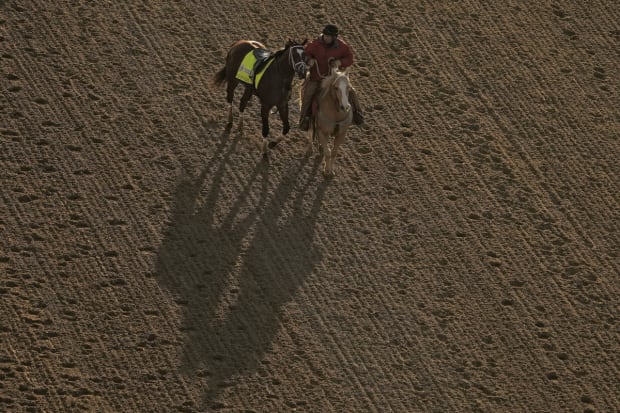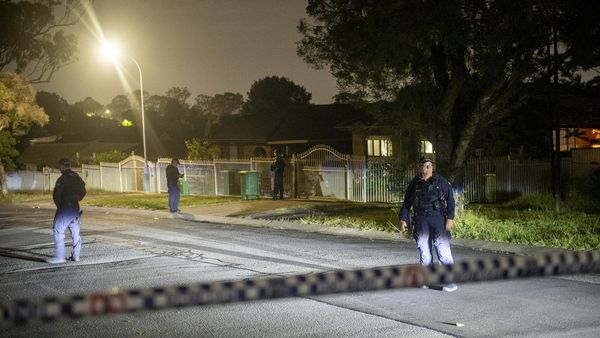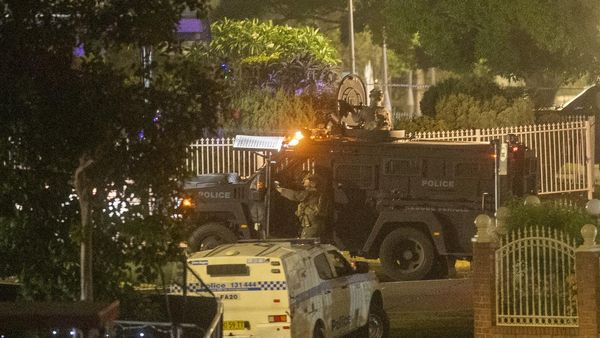The prevailing —no, overpowering—emotions at Churchill Downs during Kentucky Derby week are joy and excitement. They permeate the morning training hours, then percolate through the grandstand during the afternoon races.
But this year there is an undercurrent of tension, perhaps even dread. Unsettling things keep happening to racehorses, too jarring and numerous and awful to be swept aside by pageantry.
There were four well-publicized deaths in less than a week’s time, three during or after a race and one in training. The Daily Racing Form on Wednesday reported that a fifth death occurred Saturday night, when a horse flipped multiple times in the saddling paddock and broke its neck. During racing Wednesday, two horses were vanned off the track and returned to their barns with non-life-threatening injuries. On Thursday, Santa Anita Derby winner Practical Move withdrew after running an elevated temperature. But earlier Thursday, just two days before the 149th Run for the Roses, a chilling sound pierced the clear spring morning air: the track siren.
This was during the 15-minute training period reserved for Kentucky Derby and Oaks horses. The siren signifies a loose horse on the track, a literal danger call for other horses and riders who are on the racing surface at the time. There are a plethora of bad outcomes that are possible in those situations.
Verifying, the 15–1 colt trained by Brad Cox, threw his exercise rider on the backstretch and ran off around the track, where he was gathered up expertly by the Churchill outriders who tend to such emergencies. Verifying was guided back to Cox’s barn, examined and deemed unharmed. “We dodged a bullet,” Cox said two hours later.

Charlie Riedel/AP
But that wasn’t all. At the very time when Verifying was being walked back to his barn, an Oaks filly, And Tell Me Nolies, threw its rider and came sprinting off the track and into the barn area at full speed. It was a terrifying situation that could have ended very badly amid crowded conditions with hundreds of fans circulating. Shouts and screams went up, and people scattered for cover—myself included—as the filly’s horse shoes skidded across the asphalt and the animal clipped the side of a car before slowing down. Miraculously, that horse also escaped major injury and remains an entry in the Friday Oaks race.
“She’s O.K.,” shaken trainer Peter Miller said. “I’m not sure I am. I need to find a bar.”
This has been a compilation of largely disparate circumstances: a fatal leg injury on the dirt track, a fatal leg injury on the turf course, a broken neck in the paddock, a couple of spooked horses during training hours and a pair of sudden post-race deaths that remain unexplained.
Those latter two fatalities, both unusual occurrences, came out of the barn of trainer Saffie Joseph, who has scratched all but three of his horses for the remainder of this week. Joseph said his trainees who came into contact with the two that died—Parents Pride and Chasing Artie—will not race out of “an abundance of caution.”
But by late Thursday afternoon, there would be more scratches for Joseph’s barn.
His three Saturday entries—30–1 Derby horse Lord Miles, 2022 Derby runner White Abarrio in the Churchill Downs Stakes and Master Piece in the Turf Classic—were scratched by the Kentucky Horse Racing Commission and board of stewards. Subsequently, Churchill Downs suspended Joseph.
“Given the unexplained sudden deaths, we have reasonable concerns about the condition of his horses, and decided to suspend him indefinitely until details are analyzed and understood,” said Bill Mudd, president of Churchill Downs Inc. “The safety of our equine and human athletes and integrity of our sport is our highest priority. We feel these measures are our duty and responsibility.”
The scratch of Lord Miles from the Derby puts Japanese product Mandarin Hero into the 20-horse Derby field.
Earlier Thursday, Joseph confirmed Kentucky Racing Commission regulators came to his barn to “do their due diligence” after the two deaths—checking records and interviewing the trainer. “That’s normal protocol,” Joseph said, who was moved to tears in talking to a handful of reporters outside his barn. Joseph defended himself and horsemen as a whole amid concerns about abusing the animals in their care.
“This is the lowest of the lows you can experience,” he said. “It’s not a good feeling. It crushes you. But you can either give up, or you can keep going. I’m going to keep going.
“It’s not going to be easy going over there [to saddle Lord Miles for the Derby]. It’s going to be nerve-wracking. The pressure on me is enormous. It’s easy for me to walk away and to scratch. But that’s almost the coward way. If the horses are in good health, we have to go forward.”
The entire industry will keep going forward this week, with huge sums of money at stake on the track and, ultimately, in the breeding shed. But the PR damage up to this point has been considerable—when the biggest week of the year in the sport is awash in stories of dead horses, it’s a problem. Animal rights activists, some of whom have had racing in their sights for decades, were given fresh arguments.
“I think they should be concerned,” said Mike Repole, owner of Derby favorite Forte and an outspoken supporter of the sport. “These athletes are 1,200-pound athletes running at the highest speed. If every [human] athlete, when they break their leg, they have to be put down—there would be no sports. … There’s a lot less injuries here with legs than in other sports, but here it means that your life is over. Which, God, is as depressing as it gets.
“People will understand injuries. People won’t understand injuries with death. It’s hard to explain and say, ‘It’s going to happen once in a while.’ If you come back and watch these trainers, Todd Pletcher, tear up and cry … it’s tough. Everybody cares [about the health of the horses]. It’s the worst part of the game. It sucks.”







